
An average business has to handle hundreds, if not thousands, of contracts per year, which makes tracking and organizing them a real challenge. Contract lifecycle management, or CLM helps you transform every stage of a contract lifecycle into an efficient and streamlined operation.
What is contract lifecycle management (CLM)?
Contract lifecycle management involves managing the life cycle of contracts created and/or administered by or impacting the company. The stages of the contract lifecycle management process include requests, authoring, negotiations, approvals, signatures, obligations, compliance, and renewals.
By using contract lifecycle management tools, businesses can efficiently manage all activities related to the lifecycle of their various contracts while reducing risk, improving compliance, and enhancing overall productivity.
Types of agreements effectively managed by contract lifecycle management
Contracts come in many forms and serve various purposes within an organization. Here are a few types of contracts that contract lifecycle management platforms can help you manage:
- Sales contracts stipulate the terms and conditions of the sale of goods or services to protect the rights of sellers and buyers during the transaction.
- Vendor contracts establish the terms, conditions, and obligations associated with the purchase or provision of goods for buyers and suppliers.
- Employment contracts outline the terms and conditions of hiring for employers and employees, including duties, responsibilities, compensation, benefits, and termination clauses.
- Partnership agreements govern the relationship between individuals or entities entering a business partnership. This includes profits and losses distribution, decision-making authority, roles and responsibilities, capital contributions, dispute resolution mechanisms, and procedures to dissolve the partnership.
- Service level agreements (SLAs) regulate the relationship between customers and service providers, detailing the level of service expected from the provider, including response times, uptime percentages, resolution times, and the consequences for not meeting these service conditions.
- Lease agreements outline the terms and conditions of renting a property for landlords and tenants, detailing the lease duration, rental payments, security deposit amounts, rules regarding property use and maintenance, rights and responsibilities of parties, dispute resolution, and lease termination.
Contract lifecycle management vs. contract administration: What’s the difference?
Contract lifecycle management is often confused with contract administration, however, both approaches have some key differences.
- Contract lifecycle management involves end-to-end supervision of contracts from the creation and drafting stages to performance monitoring and renewal. The process requires specialized contract lifecycle management software, electronic signature software, contract analytics and reporting, and other tools that help streamline and automate different stages of the contract lifecycle.
- Contract administration involves regular oversight of contracts once they come into effect to ensure that parties fulfill their respective obligations. This includes performance monitoring, compliance tracking, resolving disputes, change management, and making amendments to the agreement. A contract administrator typically handles relevant day-to-day interactions, such as invoicing, monitoring deadlines, and maintaining communication between parties.
Proper contract management and administration allow businesses to ensure compliance with legal and regulatory requirements, reduce the risk of disputes, and increase the overall visibility into the contract portfolio.
5 stages of the contract lifecycle management process
- Contract initiation
The initial phase of the contracting process involves identifying the need for a contract, understanding the goals and requirements of all concerned parties, and establishing preliminary terms. Parties must ensure clear communication and careful planning to make this stage successful.
- Contract drafting and negotiation
The next stage of a contract lifecycle involves drafting the contract content, reviewing it for legal and business soundness, and engaging in a negotiation process to reach a mutually favorable agreement between parties. CLM tools and collaboration are essential to driving efficient outcomes in the drafting process.
- Contract approval
The process involves legal scrutiny, getting stakeholders’ consent, and formalizing the contract commitments with signatures from authorized individuals or approval through established procedures.
- Contract execution
With all necessary approvals secured, the contract moves into the execution phase. Here, the agreed-upon terms are implemented, goods and services are exchanged, and all parties fulfill their obligations under the contract’s directives.
- Ongoing management and renewal
The contract lifecycle doesn’t end at the execution stage—it must be consistently managed and reviewed to ensure all commitments are fulfilled. Contract administrators initiate contract renewal planning activities as the expiration date approaches. This may involve evaluating the performance of the current contract, conducting market research, renegotiating terms, and preparing for contract renewal negotiations.
What is contract lifecycle management software?
Contract lifecycle management software is a digital platform that helps organizations automate and manage the entire contract lifespan, from its creation to execution, compliance, and renewal.
What to consider when evaluating contract management software
When selecting contract management software, comparing features that align with your organizational needs is important. Consider the benefits a CLM platform can offer:
- Increased visibility. A good CLM system should provide visibility into all aspects of a contract’s journey, making every detail accessible to authorized parties. It should also provide dashboards and reports that give instant insights into the status of various contracts.
- Reduced operational costs. Look for a CLM solution that offers contract templates and standardized processes. These features can significantly reduce the time needed for contract creation and execution, leading to significant cost savings. On top of that, automating routine tasks can free up staff to focus on more strategic initiatives.
- Minimized risks.Choose a CLM tool with advanced analytics and reporting features to identify potential issues before they escalate. Also, inspect security features to verify that the solution you’re considering will protect sensitive contract information and ensure accountability throughout a contract’s lifecycle. The ability to audit and trail actions reduces exposure to contract disputes and non-compliance.
- Improved compliance. Finally, the right CLM solution should incorporate an extensive clause library for compliance with corporate standards and legal regulations and use AI to review contracts for risky clauses or non-compliance. Artificial intelligence can also suggest optimal clauses based on past agreements, further streamlining compliance.
What benefits do companies and salespeople get from CLM software
- Efficiency and productivity. By automating contract lifecycle, businesses can significantly reduce the time needed to review and process contracts, allowing legal departments to handle larger volumes of contracts with greater efficiency. In one example, a legal firm experienced an 85X increase in its contract review process speed after adopting CLM software. While it previously took up to 72 hours to review a single contract, the firm processed around 200 agreements in just one week post-implementation of a CLM solution.
- Compliance and risk reduction. Using CLM software ensures that every agreement is up to scratch with regulations, helping to reduce potential legal troubles and keep the company’s money safe. According to recent research, 65% of businesses reported a positive shift in their contract compliance after they started using a contract lifecycle management system.
- Real-time collaboration. CLM solutions help foster a collaborative environment where internal and external teams can work together seamlessly, accelerating processes and enhancing communication, leading to faster deal closures. According to recent data, almost 35% of organizations want to deploy a contract collaboration portal for joint contract editing. The same research suggests that vendors plan to prioritize CLM collaboration features by integrating their solutions with instant messaging and video collaboration tools.
- Data security and version control. A 2023 research suggests that 56% of organizations deem privacy, data protection, security, and/or data risk their top concerns when running business operations. Modern-day contract management systems offer robust security features and an auditable trail of document history to ensure data integrity and protection. By providing controlled access and version tracking, CLM software guarantees that all parties always have the most up-to-date contract information protected by industry-leading security protocols.
- Templates and clause libraries. Increasing contractual transactions have resulted in more frequent use of contract templates and AI. In the next few years, 57% of organizations plan to leverage AI, specifically focusing on contracts, e-discovery, and data privacy. Legal teams benefit from using contract templates the most—having access to a central repository of pre-approved templates and clauses allows legal professionals to streamline the contract creation processes, ensure consistency, and expedite agreement drafting.
- Advanced analytics. Analytics functionality providing real-time insights into contracts’ performance has become a critical differentiator for CLM software. In fact, 46% of organizations want to deploy contract analytics for individual agreements and scale it to their whole agreement portfolio in the coming years.
- Automated approvals. In 2021, 47% of businesses sought greater visibility into contract review and approvals compared to pre-covid years (36%). That is no surprise, as the automated contract approval process has proven to reduce compliance risks, ensure proper authorization at each stage of the contract lifecycle, and accelerate the overall contract management process.
How to use SignNow for your contract management process
airSlate SignNow enables companies and individuals to move fast with everything they need to send and e-sign their documents. Although SignNow positions itself as an electronic signature and document automation solution, customers across different industries use it for contract management.
SignNow has proven to be extremely helpful in a number of industry use cases. Here’s how you can use SignNow to elevate your contract process:
1. Request attachments during contract preparation
At the contract preparation stage, contractors develop a roadmap for their business relationship. This is also when the documents and quotes needed to draft a contract are collected, and the key contacts are identified.
Using SignNow’s Attachments feature, the contract’s author can request that signers attach extra files. Requesting a document package from the signer before they e-sign a contract or agreement is possible. . All it takes is to place the Attachment field where needed within the document and then specify the attachment type.
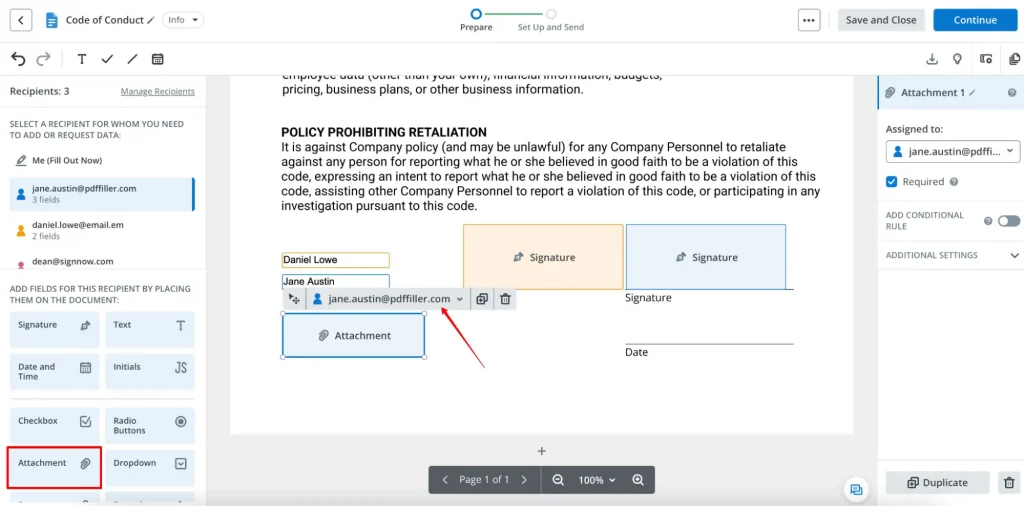
2. Draft a contract using document templates
Drafting a contract is the next stage of the contract management process. By writing out terms and conditions, the parties consent that they fully understand their legal obligations and responsibilities towards one another.
Typically, the draft is based on the quotes and documents obtained during the contract preparation stage. The draft contract must use clear wording to avoid confusion and ambiguity.
In paper-based workflows, drafting a contract can sometimes result in bottlenecks caused by involving different stakeholders. SignNow allows users to create contract templates from existing documents and edit them by adding fillable fields.
This way, it is possible to speed up the process and exclude burdensome interactions. What’s more, SignNow eliminates paper-pushing with its searchable database of ready-made forms.
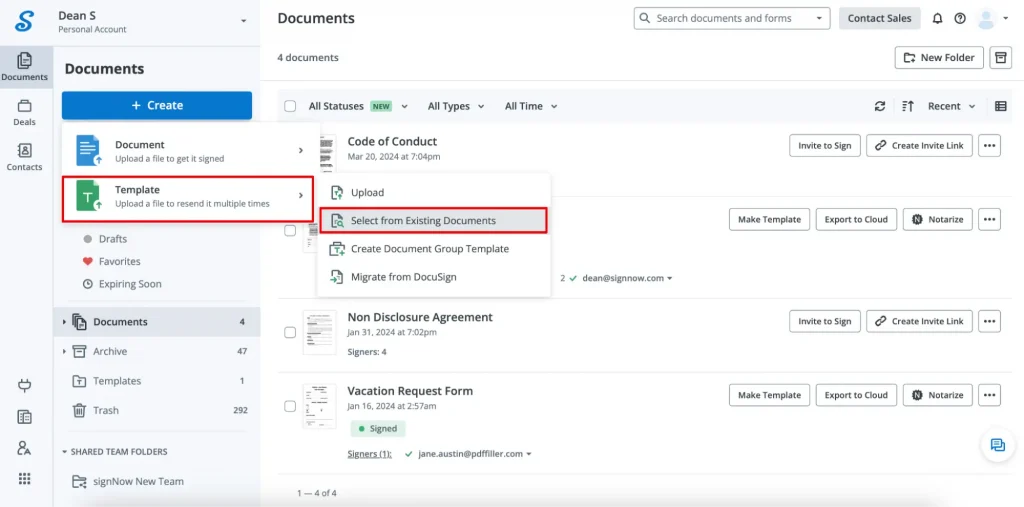
3. Optimize contract negotiations
At the contract negotiation stage, the drafted contract is circulated among the key stakeholders to gather feedback and identify possible issues. Once the feedback is collected, the parties negotiate the terms and conditions until they reach a final agreement. Eventually, the suggested revisions are documented, and the contract is prepared for formal approval.
With SignNow, you can optimize the contract negotiation stage in a few clicks. Feel free to add fillable text fields to get instant feedback and get notified about the contract changes.
Using SignNow as part of the airSlate Business Cloud, you can pre-fill, comment on, redline, and approve contracts within a single platform. It is also possible to set up role-based contract routing when executing e-signatures.
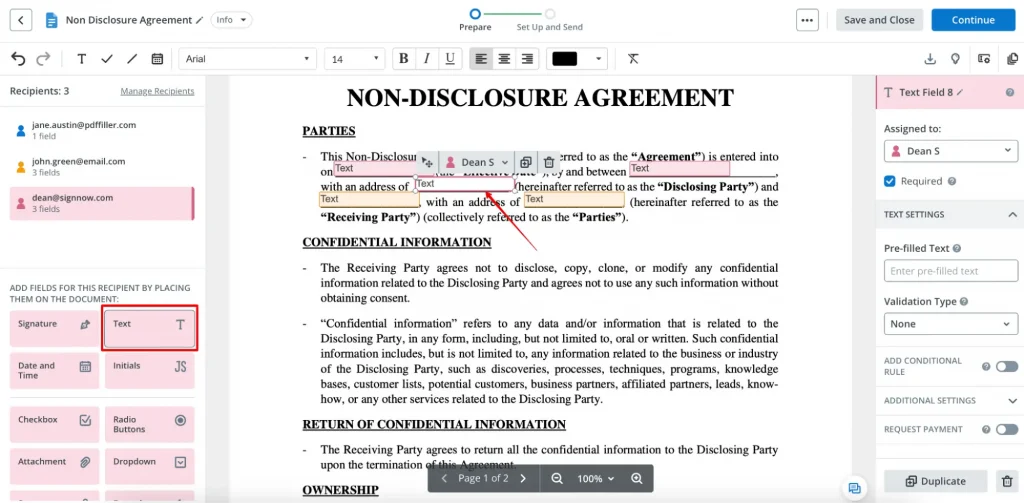
4. Accelerate the contract approval stage
The contract approval stage typically involves a legal team, key stakeholders, and management. Depending on the size and scope of the contract, it is possible to use one of the following approaches:
- Parallel approvals with various departments collecting signatures simultaneously
- Serial approvals with signatures collected in a consecutive order.
Using paper-based workflows often ends up being a time-consuming affair during the approval stage. SignNow allows for setting up a workflow to ensure that whoever needs to approve a contract can view, modify, and comment on it in real-time. Using e-signatures can simplify the signature collection process, primarily if the involved parties reside in different time zones.
5. E-sign and store contracts with minimal effort
Once a contract is approved, the parties add their signatures to finalize its execution. At this point, the parties should have no objections about the terms and conditions of the contract and understand how it will work. Finally, copies of the signed contract are distributed to all parties for further storage.
When it comes to paper-based contracts, the contract management process usually stops right here for many businesses.
With SignNow, the “sign and forget” attitude doesn’t cut it. E-signatures are legally binding, secure, and easy to use. One can e-sign a contract or invite other signers on the go using a mobile phone or tablet. Not only is it possible to send signature invites and customize signature workflows, but it is also possible to store signed contracts for later use. Storing contacts on an online server makes them easily accessible for auditing and renewal.
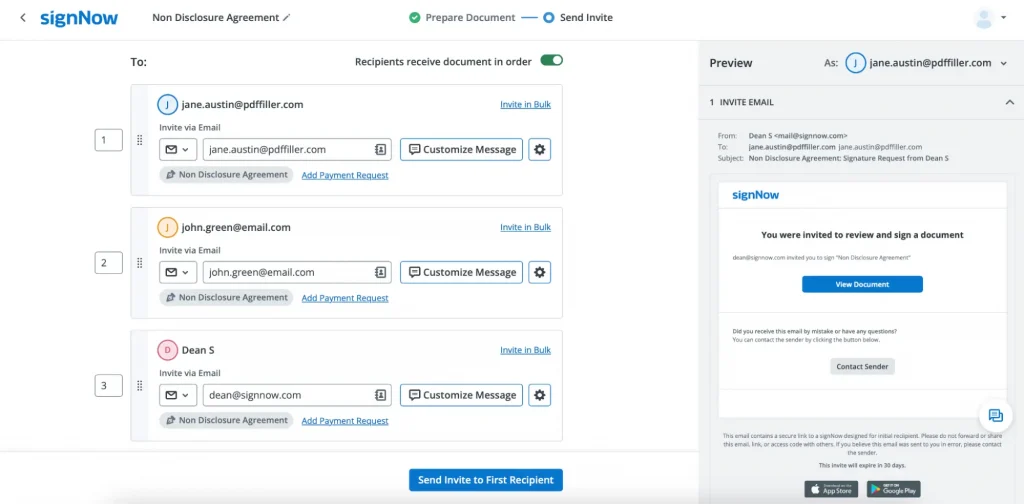
6. Report and audit contracts by keeping track of every change
Contract management doesn’t end with signatures being in place. Auditing and reports help ensure a contract is properly executed and its obligations are met. Identifying any hazards that may put a contract’s validity at risk and eliminating them before any violations occur is crucial.
SignNow’s Audit Trail tracks complete document histories and e-signature steps to ensure customer information is secure. Using the ‘History’ feature, one can trace contract changes at any stage of the signing process.
It is possible to see who accessed a contract, when the changes were made, and view timestamps and IP addresses linked with the actions in a document.
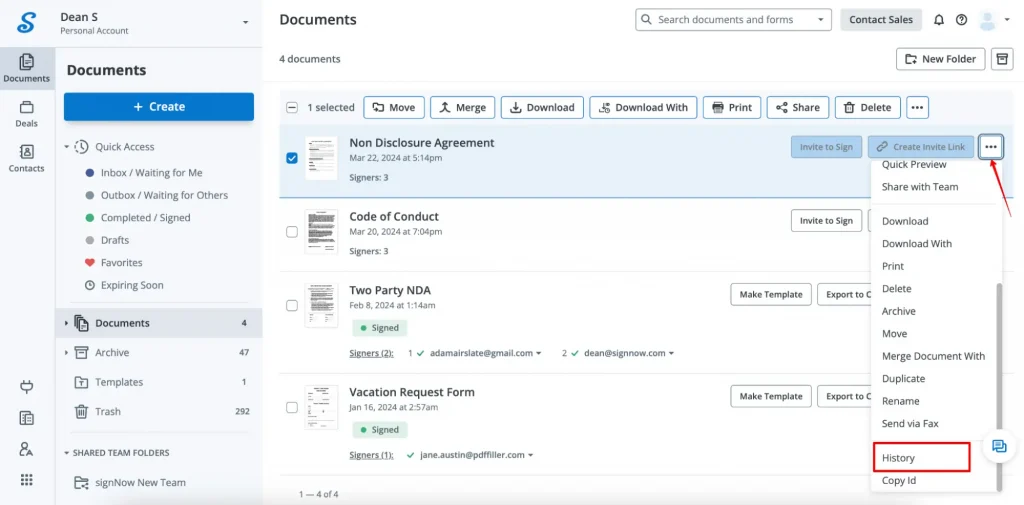
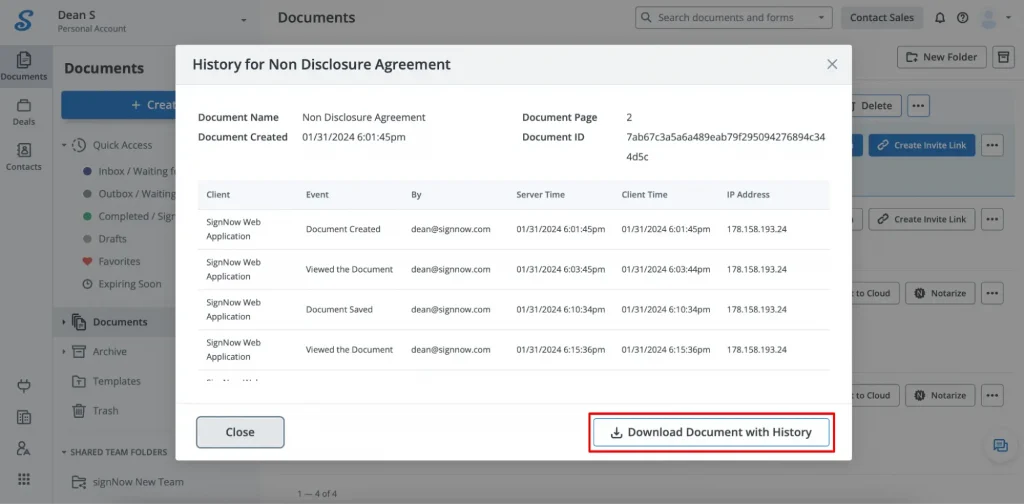
Watch the video below to learn how to enhance your contract management process with SignNow:
Streamline your contract process with contract lifecycle management
Contract Lifecycle Management (CLM) is a critical tool for modern businesses, essential for overseeing agreements efficiently, minimizing security risks, and ensuring compliance to add real value.
E-signatures, like those from SignNow, are crucial for making contract management faster and more cost-effective, helping to handle documents and secure data at every contract stage efficiently.
- What is contract lifecycle management (CLM)?
- Types of agreements effectively managed by contract lifecycle management
- Contract lifecycle management vs. contract administration: What’s the difference?
- 5 stages of the contract lifecycle management process
- What is contract lifecycle management software?
- What to consider when evaluating contract management software
- What benefits do companies and salespeople get from CLM software
- How to use SignNow for your contract management process
- Streamline your contract process with contract lifecycle management

